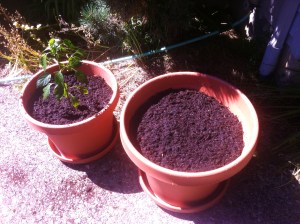I’m going to tell you about a special pot of beans.

First, the occasion: my mother and stepfather have moved here. Let’s try that again: MY MOTHER AND STEPFATHER HAVE MOVED HERE. They’re living in an apartment not 15 minutes from my house. This is the first time I have ever lived in the same city with my loving, thoughtful, dangerously witty fisherman stepfather, and it’s the first time in over 10 years that I’ve lived in the same city with my inspiring, intuitive mother (who, for the record, usually manages to out-fish my stepdad). So last Friday, we had a small family gathering to celebrate their arrival. We had some champagne to drink. Hence, I had a pot of beans to assemble.
A pot of beans, though? How do you elevate a pot of beans to something worthy of such an auspicious occasion? You take your time, tasting as you go, and you enjoy the process. And why choose beans when the bounty of the Pacific Northwest is available at the seafood shop just across the bridge? Because in our world, beans are a true comfort food. They’re all about coming home. And because my mom said, “Just throw something in a pot. One pot. Keep it simple.”
Welcome Home Chili Beans
Serves 6 big eaters with leftovers for a nice lunch or two.
Takes about 4 hours if you’re making your own stock and doing everything the day of serving. 3 hours if you’re an efficient multitasker for a living, like me. You could probably do this in the span of 1.5 hours if you’re using canned beans, boxed stock, and like to feel rushed. OR, if you roast your squash and garlic and make your Umami Bomb and Chile Stock a day ahead, and your beans are soft and ready, shit–this could take you like 45 minutes total. It’s a choose-your-own-adventure cooking experience.
Here’s what you need:
- 1 2.5 pound butternut squash (or an equal quantity of sweet potatoes), peeled and cut into 0.5-0.75″ cubes
- 3-4 slices of uncured bacon
- 2 large carrots, diced
- 3 stalks celery, diced
- 1 large sweet onion, diced
- 1.5 pounds of dry black beans, soaked overnight/forever until soft OR like three or four cans of black beans with some of the liquid reserved (OR, if you’re like me and find that soaking dry black beans overnight does next to nothing, pop 1.5 lbs dry black beans in a pressure cooker with water to cover by several inches and cook on high for 22 minutes, using natural release method to liberate your beans)
- The strays in your fridge/counter. Mine yielded 2 small leeks, a little red potato, and 1.5 cups of mildly seasoned cooked chicken breast. I’d totally use the chicken again in another iteration.
- a couple bay leaves
- 1 tablespoon ground cumin
- 1 teaspoon ground coriander
- 1-2 tablespoons chili powder–Now, if you have some nice powdered ancho chile, use it. If you have the crap from the spice aisle with the green lid that just says “chili powder,” use it. You don’t have to be a chili powder snob here. You’re already using dried chiles in this recipe so you’ve got some some cred. And just note that each powder has its own potency. You’ll have to add this one to taste, and that’s okay. Each pot of beans is a unique snowflake.
- Lots of stock.Well, probably at least 4-6 cups depending upon how thick or thin you want your beany goodness. You want a good quality low-sodium chicken broth in a box or better yet, a chicken or veggie broth you’ve made yourself at home. I used something I’m going to call my Odds and Ends Chile Stock… scroll on down to the notes below to see how I usually do it. I’m probably not giving it enough credit for the deliciousness of this pot of beans.
- 1 recipe Pot Bean Umami Bomb, below
- salt
- pepper
- mild vegetable oil–olive, canola, or grapeseed
Okay. Take heart. This is not a difficult recipe by any means, but it does require a little time and assembly. First, preheat your oven to 400 degrees. Now is a good time to get the stock going on the stovetop as outlined below, if you’re going that route. Toss the cubed butternut squash in 1-2 tablespoons of oil and prepare a head of garlic for roasting as well. Pop these into the oven and let them go for 30-45 minutes, checking in occasionally to ensure that your squash is not burning. When the squash is cooked to your liking (I like mine just shy of burnt), pull everything out of the oven and set aside. And try not to eat all the squash while you do everything else.
While your stock is finishing up, dice your carrots, celery, and onion (and save those ends for more stock!). Finally, slice your bacon into strips widthwise. If you’re like me and want to use the same pot for the stock and the beans (mom said to use just one), finish your stock and pour it elsewhere to get your pot back. Heat the pot on medium high heat. Add the bacon. Cook until it reaches your desired level of crispness. If your bacon has put off more than a tablespoon or two of fat, spoon some of it out into the jar of bacon fat you keep in your fridge. (I’m just assuming you have one by now). Add the onion, celery, and carrots and saute until the onions are starting to turn translucent and the carrots are beginning to soften. Now, add the chili powder, coriander, cumin, bay leaves, and a teaspoon or two of salt. Continue to saute as the spices get aromatic and coat the sweaty vegetables. If you’re doing cubed chicken, add it here, along with any other fridge strays. Then add your beans and mix everything up. Slowly add stock while stirring so you can see exactly how thin you’re making your chili. I probably used about 4 cups of broth and a cup of pot liquor (the thick inky liquid left over from cooking my beans). If your beans weren’t quite soft enough, simmer this mess until they’re to your liking.
Once your beans are soft enough BUT NOT BEFORE, dump in your Umami Bomb and add salt to taste. A squirt of lemon juice at this point is a nice touch, too. The thing is, if you add acids like tomatoes and lemon juice before your beans are soft, they’ll be a bitch to soften.
Let everything simmer and mingle for a while. Half an hour. However long it takes to get your in-laws and parents wrangled around the table with drinks in their hands. Taste for salt and add if you need to. Set out an array of fixins. Mine included:
- rough-chopped cilantro leaves
- sour cream
- diced raw red onion
- shredded cheddar
- lime wedges
- broken corn chips–oh man, we had a random bag of Fritos hanging around. Heaven.
Avocado would be great here, too. Damn. Now that I type that, I realize I should have had it. Just gonna have to do this again.
I set the pot in the middle of the table–the big, functional, less-than-gorgeous pot– along with my biggest measuring cup to use as a ladle, since I find that our ladle is tiny and I’d rather not have to scoop fifteen times to get the serving I want. Whatever. It wasn’t about the pot, or the measuring cup.
I do not have a pretty food blog-y picture of the finished product. I was too busy with the champagne and the broken chips and the warm fuzzies. My mom and stepdad, my mother- and father-in-law, Jesse, and me: the six of us fit snugly around our table. But before we sat down, while the beans finished, we traveled as a cluster from living room to kitchen to dining room. We just wanted to be near each other, sharing stories of cross-country road trips, of sketchy motels in Wyoming, of leaving the Midwest.
~~~
Odds and Ends Chile Stock
Ingredients
- 2-4 ounces whole dried chiles–New Mexico, guajillo, or ancho are good choices. Anchos are my favorites for their sweetness and quiet smokiness. You can find these at lots of upscale grocery stores–Whole Foods, I’ m looking at you–but you’ll find them cheapest at your local, well, cheapest grocery store. Rainbow, Festival… I got this bag for $3.99 at the Albertson’s down the road. And I live in a 90% white suburb. If you’re in Minneapolis, there’s a Rainbow on (East) Lake that I’m really missing for shit like this.

- 1-2 gallon freezer bags full of discarded vegetable ends. The bruised top layers of onions. The butt ends of carrots and celery and squash. Cloves of garlic that were so tiny they were impossible to chop without causing homicidal rage. Kale spines, cilantro stems. If you’re not saving these bits already, it won’t take you very long to fill up a bag. Keep it in your freezer. If you’re not saving ends and want to make your own veggie stock, break up a couple large carrots and two stalks of celery, and quarter three or four large onions.
- a couple bay leaves
- 6-10 whole peppercorns
- rind of a hard cheese, like parmigiano reggiano (optional, but it adds an incredible layer of oomph to your stock)
Heat a very large (6 quart or more) pot over medium high heat. Remove and discard the stems, veins, and seeds from the chiles. Drop them in the hot pot and let them soften and release their aroma, but don’t let them burn. Give them 3-5 minutes, moving them around to prevent outright searing.

Next, plop in your veggies. They can come straight out of the freezer. Fill your pot with enough water to submerge all the solids. Throw in your bay leaves, peppercorns, and cheese rind if using. Raise the heat to a very bare boil and then immediately turn it down to a low simmer–so low that you see a bubble rise to the surface every second or two. Walk away for at least an hour. When I made mine last week, I think I let it go for two hours. You can’t really overdo it.

Once your stock has simmered long enough, it’s time to remove the solids. Try to save the chiles; the rest is great for a compost pile. The chiles will sort of look like slimy roasted red peppers. Reserve them for the Umami Bomb we’ll talk about next. Don’t waste your time or your cheesecloth straining the stock further to clarify it. Ain’t nobody got time for that.
Pour finished stock into freezer bags and, if you’re up for it, label the bags with the dates/what kind of veggies you used, especially if you had some pungent ones in there. Stock made of brussels sprouts leaves might not work in all applications, for instance. The stock can be stored in the freezer for a very long time.
Pot Bean Umami Bomb
This little concoction is something that will add a nuanced layer to any pot of beans or chili you’re putting together. Umami is the savory meaty flavor of glutamates and nucleotides that is so often the missing element when you taste a dish and find it lacking “something.” Crescent Dragonwagon seems to use this technique a lot in her delightful cookbook Bean by Bean: to ensure a nice round flavor, she mixes up a cup or two of some umami-rich ingredients and adds it to the main pot towards the end. Kind of feels like cheating, but hey. Here’s my version, and it requires:
- the spent chiles that you reserved from your spent stock veggies (or 2-4 ounces of chiles you heated on the stovetop and then steeped in 1 cup of boiling water–chile tea!)
- 1 can tomatoes (diced/crushed/whole makes no matter; fire-roasted is great, if you have it)
- 2 tablespoons tomato paste
- half a teaspoon of fish sauce
- 1 head roasted garlic (make it this way and you’ll feel very clever)
- a tablespoon or two of tamari/gluten-free soy sauce
Blend all of the above in a food processor/blender until smooth, and keep it at the ready.





































